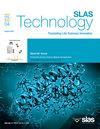Automatic cleaning in acoustic ejection mass spectrometry: Enhancing the system robustness for large-scale high-throughput analysis of complex samples
IF 2.5
4区 医学
Q3 BIOCHEMICAL RESEARCH METHODS
引用次数: 0
Abstract
The rapid evolution of high-throughput mass spectrometry (HT-MS) technologies has positioned MS as a pivotal analytical tool across diverse disciplines. Its significance is particularly pronounced in high-throughput drug discovery and development, where MS plays a critical role throughout various phases. Acoustic ejection mass spectrometry (AEMS) is a recent addition to the HT-MS landscape, showcasing a balanced performance high analytical throughput and high data quality. Particularly, AEMS's in-line dilution feature allows the direct analysis of large-scale, complex reaction solutions without the need for sample cleanup, making it a popular choice for large-scale high-throughput screenings. However, the substantial volume of complex matrix introduces concerns about system robustness, specifically regarding the potential clogging of the sample transfer line. This study addresses this challenge by introducing an integrated automatic washing feature to the AEMS system. This enhancement significantly improves system robustness without imposing any additional demands on assay execution time. Demonstrating an extended electrode lifetime, the cleaning approach proves effective in maintaining system performance over prolonged periods, showcasing its potential for continuous large-sample-scale high-throughput analysis applications.
声发射质谱仪中的自动清洁:增强系统鲁棒性,实现复杂样品的大规模高通量分析
高通量质谱(HT-MS)技术的飞速发展使 MS 成为各学科中举足轻重的分析工具。在高通量药物发现和开发领域,质谱仪在各个阶段都发挥着至关重要的作用,其意义尤为突出。声发射质谱(AEMS)是最近加入 HT-MS 领域的一种新技术,它在高分析通量和高数据质量之间实现了平衡。尤其是 AEMS 的在线稀释功能可直接分析大规模的复杂反应溶液,而无需进行样品清理,因此成为大规模高通量筛选的热门选择。然而,大量的复杂基质会引起对系统稳健性的担忧,特别是样品传输线的潜在堵塞。本研究通过在 AEMS 系统中引入集成自动清洗功能来应对这一挑战。这一改进大大提高了系统的稳健性,而不会对检测执行时间造成额外要求。清洗方法延长了电极的使用寿命,证明它能有效地长时间保持系统性能,展示了它在连续大样本高通量分析应用中的潜力。
本文章由计算机程序翻译,如有差异,请以英文原文为准。
求助全文
约1分钟内获得全文
求助全文
来源期刊

SLAS Technology
Computer Science-Computer Science Applications
CiteScore
6.30
自引率
7.40%
发文量
47
审稿时长
106 days
期刊介绍:
SLAS Technology emphasizes scientific and technical advances that enable and improve life sciences research and development; drug-delivery; diagnostics; biomedical and molecular imaging; and personalized and precision medicine. This includes high-throughput and other laboratory automation technologies; micro/nanotechnologies; analytical, separation and quantitative techniques; synthetic chemistry and biology; informatics (data analysis, statistics, bio, genomic and chemoinformatics); and more.
 求助内容:
求助内容: 应助结果提醒方式:
应助结果提醒方式:


